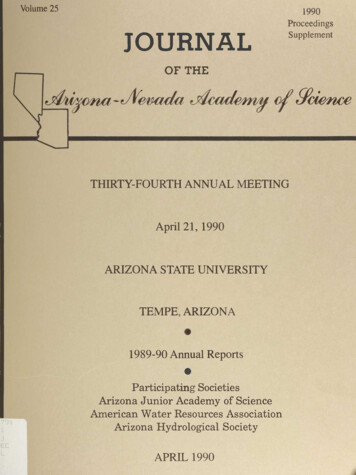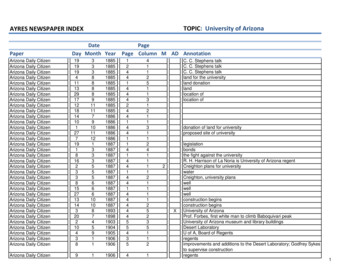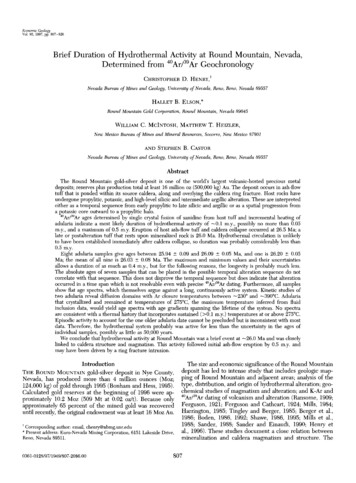
Transcription
Volume 251990ProceedingsSupplementOF THETHIRTY-FOURTH ANNUAL MEETINGApril 21,1990ARIZONA STATE UNIVERSITYTEMPE, ARIZONA 1989-90 AnnualReports Participating SocietiesArizona Junior Academy of ScienceAmerican Water Resources AssociationArizonaHydrological SocietyAPRIL 1990
PROCEEDINGSOF THE34TH ANNUAL MEETINGOF THEARIZONA·NEV ADA ACADEMY OF SCIENCEApril 21, 1990Arizona State UniversityTempe, ArizonaINDEXPageAbbreviated Meeting ScheduleSummary of Section MeetingsAbstracts ofAnthropologyBiology IBiology IIPapers Presented23at SectionIConservation IGeneral and Physical Science(Symposium on Symmetry)GeographyGeologyHydrologyScience Ed.ucationSpecial SessionReports of OfficersofASU451218232628323839and CommitteesOfficers and Section ChairpersonsCommittee RosterPresident's ReportMinutes of the Annual MeetingMembership CommitteeNominating Committee ReportEditorial Board ReportTreasurer's ReportDirector's ReportJunior Academy ReportMapMeetings4344454648484950515153Campus1
ABBREVIATED SCHEDULE AND ACTIVITY LOCATIONSFriday April 20All activitiesArizona.6:30onFriday eveningP.M.7:00·8:00will takeExecutive BoardplaceattheHoliday Inn,Rural Road,Tempe,Meeting, room will be postedReception, room will be postedNo host bar, Free hors d'oeuvresEarl y registrationSaturday April 21All activities will take place in the GState University (see map).wingof theEngineering Building,Arizona7:00 A.M.Registration will be held outside on the west side of the building onthe ground floor8:00-10:00Paper Sessions (See Section Schedules)10:00-10:30Coffee Break at10:30-12:00Paper Sessions (See12:00-1:40Annual Academy Meeting and Awards Luncheon, StudentUnion, Arizona Room, Second Floor1 :45-3:00Symposium1 :45-3:00Special Paper1:45Junior3:00-3:30Coffee Break3:30-5:00Continuation of Symposium on Symmetry andSession Honoring Gerald A. Cole5:00GoverningNote: A map of the dules)Room 347Honoring GeraldAcademy Sessions,atareaRoomsA.Cole, Room 324227, 228, 236and 237Registration areaBoardMeeting,is locatedat2Special PaperRoom 324the end of theProceedings
SUMMARY OF SECTION phyI8:00201GeologyI8:00227HydrologyI8:00228Science EducationI9:00201Symposium on SymmetryI1:45347Special Paper SessionHonoring Gerald A.ColeI1:45324Junior Academy*Indicates1:45Paper to be considered for the Best Student Paper Award3227,228236,237
ANTHROPOLOGYSESSION I:8:00Room: 215Chairperson:Rick EfflundThe abstracts for this sectionwere notreceived in timetoinclude in theProceedings.10:00-10:30COFFEE BREAK12:00-1:40ANNUAL MEETING AND AWARDSSTUDENT UNION1:45SPECIAL PAPER SESSION:HONORING GERALD A. COLEROOM 3241:45SYMPOSIUM ON SYMMETRYROOM 3475:00BOARD MEETINGROOM 3244LUNCHEON,
BIOLOGYSESSION I:8:00Room: 236Chairperson:8:00-8:15Robert W. BowkerTHE AVIFAUNA OF THE CHIRICAHUACOCHISEMOUNTAINS,COUNTY, ARIZONARoy Johnson, Michael R. Kunzmann, and Kathy Hiett (National Park Service,University of Arizona, Tucson)R.The Chiricahua Mountains of southeastern Arizona are widely known as one of thepremier birding localities in the United States. Professional ornithologists and amateurbirdwatchers alike have conducted studies here for most of this century. Several Madreanwoodland and forest species from northern Mexico reach the northern limits of their rangeshere. The majority of the breeding population for several species in the United Statesoccurs in the Chiricahua Mountains, although individuals or small nesting populations maybe found sporadically and/or in limited numbers elsewhere. Such species include theWhiskered Owl tOtus trichopsis), Elegant Trogon (Trogon elegans), Sulphur-belliedFlycatcher (Myiodynastes luteiveniris) and Mexican Chickadee (Parus sclateri). Theauthors are preparing the first annotated checklist for the mountain range.8:15-8:30ON THE APPLICABILITY OF GENERALIZED FIREPRESCRIPTIONS TO BURNING OF MADREANEVERGREEN WOODLAND FOR MANAGEMENTPURPOSES.Peter Bennett and Michael Kunzmann (Cooperative National Park Resource Studies Unit,University of Arizona, Tucson, Arizona)Perfection of the National Fire Danger Rating System (NFDRS), published in 1972,disseminated fire behavior models nationwide, modeling fire behavior for firepresuppression planning and suppression activities, ignoring many ecological implications.Wide acceptance of the NFDRS has tended to emphasize fire mechanics such as predictionof burning index, spread rate, and fuel reduction. Prescription fires set in the ChiricahuaMountains, Arizona, have been primarily aimed at fuel reduction and cover typemodification. Models for fire effects on Madrean Evergreen Woodlands, (a communityrestricted to southeastern Arizona and the Sierra Madre Occidental) are lacking. Biologicaland paleontological research on the role of fire in Madrean exosystems is scant and theresults are conflicting. Fire prescriptions in southeastern Arizona are being formulatedwith the assumption that the Madrean woodland ecology is the same as elsewhere in themontane west. Research to support this contention is lacking. This paper examines theevidence available and makes suggestions for future research.5
8:30-8:45FACTORS AFFECTING AVIAN SPECIES RICHNESS INTHE CHIRICAHUA MOUNTAINS, COCHISE COUNTY,ARIZONAMichael R. Kunzmann. Peter S. Bennett, and R.University of Arizona, Tucson)Roy Johnson (National Park Service,The Chiricahua Mountains of southeastern Arizona have been widely studied byto a lesser degree, botanists during the past several decades. The area iswell known for its unusually high avian species richness. An annotated flora of theChiricahuas being prepared by the authors suggests that the range may also contain a highfloral richness. Additionally, a diverse assemblage of vegetational types results fromseveral phytogeographical factors including (1) large number of altitudinal zones (2)meeting of Petran (Rocky Mountain) species from the north and Madrean (Sierra MadreOccidental) species from the south and (3) semidesert grassland on its western flanks andChihuahuan Desert scrub on its eastern flanks. This paper examines these and otherbigeographical characteristics of the mountain range and their influences on avian speciesrichness.ornithologists and,WATER VELOCITY, PROTECTIVE COVER, PREDATION;THREE FACTORS INFLUENCING CANAL FISH8:45-9:00COMMUNITIESGordon Mueller(U.S. Bureau of Reclamation, Boulder City, Nevada)The concrete lining of the Coachella Canal, California and recent increases in waterdiversions for the Hayden-Rhodes Aqueduct, Arizona have reflected declines in canal fishdiversity, density and biomass. Declines are being attributed to increases in water velocityand predation in habitats devoid of protective cover. Lentic and cover-oriented fishes, suchas centrarchids and flathead catfish, appear unable to tolerate the high velocities associatedwith these concrete lined habitats.The Bureau of Reclamation initiated an artificial reef study to test the compatibilityof optimizing canals for both water conveyance and fishery resourses. Preliminary resultsare encouraging. Reefs are showing significant increases in the numbers of largemouthbass, sunfish and flathead catfish without affecting water conveyance.9:00-9:15THE ROLE OF LOCAL LANDMARKS IN DAILYMIGRATIONS OF BROWN SURGEONFISH(ACANTHURUSAnthonyArizona)1. Mazeroll and W. LinnNIGROFUSCUS) IN THE RED SEA.Montgomery (Northern Arizona Univeristy, Flagstaff,Brown Surgeonfish (Acanthurus nigrofuscus) migrate up to three times dailyduring the summer spawning season in the upper Red Sea (Gulf of Aqaba, Israel).During May September 1988 and June August 1989 we attempted to determine the useof landmarks by migrating brown surgeonfish. Four different landmarks weremanipulated by either moving the actual structure or else by moving a model of the-landmark while the actual landmark-wascovered withablue cloth. One landmarkwasmanipulated during the morning migrations to feeding sites, while three landmarks weremanipulated during the evening migrations to spawning sites. Alterations to or movement6
of these landmarkscauses (a) initial confusion with subsequent continuation of migration,of(b) realignment the migration route to visit landmarks in their new position. Fishtolerate minimal disturbance of landmarks: if landmarks are moved beyond 3 10 metersfrom the original position, they will ignore the landmark and return to their original route.or-9:15·9:30*FACTORS INFLUENCING PARASITISM RATE OFFOREST TENT CATERPILLAR (MALACOSOMA DISSTRIA)PUPAE (LEPIDOPTERA: LASIOCAMPIDAE)Rhonda Snook (Arizona StateThisstudyUniversity, Tempe, Arizona)addressed the overall rate of parasitism of forest tentcaterpillar(Malacosoma disstria) pupae and the influences of: 1) the plant on which pupation occurs,("Pupation species"), 2) spatial position of the pupae (i.e, horizontal and vertical), and 3)cocoon density, on the fate of pupae during an outbreak year in northern Michigan. Overallparasitism on all categories was greater than 97% and was not significantly influenced bythese three factors. However, pupation species and cocoon density influenced the relativeabundances of different parasatoids asocciated with M. disstria. Dipteran parasitoid specieswere relatively underrepresented among pupae on white pine (Pinus strobus) andoverrepresented among pupae on red maple (Acer rubrum). There were relatively moreSarcophaga aldrichii and fewer other dipteran species that was expected parasitizing solitarycocoons. These results may be explained in part by chemical stimuli associated with thepupation species, optimal foraging strategy and/or artifacts of sampling.9:30-9:45LIGHT AND ELECTRON MICROSCOPE OBSERVATIONSOF TELISPORE GERMINATION IN A RUST FUNGUSRobert W. Roberson(Arizona State University, Tempe, Arizona)Cytological features of germinating teliosporse of the common rust fungusGymnosporangium clavipes Cke. & Pk. were examined using light and transmissionelectron microscopy, LM and TEM respectively,. LM observation of living cells were madeusing Nomarski optics. Developmental changes in the microtuble cytoskeleton and nuclearmigration were examined using epiflouresence techinques. For TEM, non-germinating andgerminating teleospores were cryofixed by either high pressure freezing or rapidly plungingspores into liquid propane followed by freeze substitution. Mature teliospores of G.clavipes were two celled. The cytoplasm contained a dense ground matrix in whichmitochondria, glycogen, endoplasmic reticulum, and vacuoles were observed. A singleprophase nucleus was present in each cell. During germination a germ tube emerged fromthe germ pore region of each cell, exhibiting a highly polarized mode of apical growth.Cytoplasmic vesicles were numerous in the tip region of elongating germ tubes.Microtubules were abundant in the germinating teliospore and elongating germ tubes. Thenucleus migrated into the germ tube and divided meiotically. Centripetally developing septadivided the germ tube into four uninucleate cells, each of which gave rise to a singlesterigma. Subsequently, at the tip of each sterigma a basidiospore initial developed.Numerous cytoplasmic vesicles were observed at the tips of each developing sterigma andin the basidiospore intials. The haploid nucleus migrated into the basidiospore initial andunderwent a single mitotic division. During this time a septum developed in each sterigmadelimiting the binucleate basidiospores.7
9:45 10:00.A CLADISTIC ANALYSIS OF MONOPHYLY OF FAMILIESIN THE CONJUGATING GREEN ALGAE(ZYGNEMAT ALES )Richard M. McCourt (DePaul University, Chicago, lllinois) and Robert W. Hoshaw(Univrsity of Arizona, Tucson, Arizona)The conjugating green algae (Order Zygnematales) constitute a natural, ormonophyletic, group of some 54 genera, including unicells, filaments, and a few colonialtypes. Most authors have recognized a family of filamentous thalli (Zygnemataceae, 12genera), a family of unicells with unsegmented cell walls (saccoderm desmids, ofMesotaeniaceae, 6 genera),and one or more families of primarily unicellular forms withsegmented, ornamented cell walls (placodern desmids, of Desmidiaceae, ca. 36 genera).In some treatments each of these families is considered monophyletic; in others the generaare placed in explicitly polyphyletic groups, i.e., certain filaments and saccoderms havebeen considered closely related on the basis of chloroplast form and other characters, butthey have been nevertheless put in separate families according to grade of thallus evolution(filament or unicell). We have attempted a parsimony analysis of available morphologicaldata (thallus type, chloroplast form, reproductive characters, etc.) to resolve the cladisticrelationships of genera in these families and to trace character evolution in the order.Preliminary results indicate that the placoderm desmids are a monophyletic group,whereas monophyly of the Zygnemataceae and saccoderm desmids appears to be weaklysupported. Assuming that a filamentous thallus is primitive in the group (Klebsormidiwnis the outgroup), unicellularity and various chloroplast forms appear to have evolvedseveral times within the Zygnematales. Within the placoderm desmids, filamentous andcolonial growth forms seem to have evolved independently of their origins in the rest ofthe Zygnematales.10:00 10:30COFFEE BREAK10:30 10:45THE EFFECTS OF ESTROGEN AND PROGESTERONEON TOLERANCE TO THERMAL STRESS.Kris A.Lyon (University of Nevada, Las Vegas,LasVegas, Nevada)The purpose of this study was to determine the effects of estrogen and progesteronebody temperature and tolerance to thermal stress of female Harlan Sprague-Dawley rats.Analysis of variance showed that rats treated with estradiol benzoate (EB) and progesterone(P) had a significantly higher rectal temperature (Tre) than untreated control animals andthose treated with EB or P alone. In rats treated with EB, Tre was significantly higher thanthe control animals and those treated with P. All treatment groups had a significantly lowerontail skin temperature (Tsk) than the control animals. The rise in Tre did not appear to resultfrom an increase in metabolism since the rates of oxygen consumption did not differsignificantly with hormone treatment. The rise in Tre ofEB-P and EB treated rats mayhave resulted from a decrease in heat loss as evidenced by the lower Tsk. Thermoregulatoryresponses of rats exposed to acute heat and cold stress did not appear to be affected by thehormone treatment.8
10:45-11:00*LIMNOLOGY OF DESERT STREAM POOLSDalaine 1. Wood and Stuart G. Fisher(Arizona State University, Tempe, Arizona)In low desert streams, pools represent a lentic enviromnent embedded in a loticecosystem. Three pools and three riffles in Sycamore Creek, Maricopa County, Arizonawere compared in terms of their resistance and resilience to disturbance by floods. Poolsstratified on a diel basis with as much as a 50 C and a 6 mg/l dissolved oxygen differenceobserved within one meter depth. Riffles did not stratify although some patchiness intemperature and oxygen was observed. For all pools, there were no significant differencesin NH4-N or N03-N concentrations between inlets and outlets. Soluble reactivephosphorus (SRP) concentrations differed between the head and outlet for only one pool;however, significant differences in NlJ4-N and SRP were found between the surface andbottom of two pools. On July 21 a low magnitude flood buried benthic periphyton with anaverage of 9 em of silt which increased organic content of the substratum by an order ofmagnitude. Chlorophyll decreased rapidly and recovery was slowed by the turbidity of thewater. Turbid conditions soon cleared in the riffles but persisted in the pools for 6 weeks.Recovery of algae and macrophytes was more rapid in riffles than in pools. Siltation byminor flooding may be as serious a disturbance event as scouring by flash floods but itsmode of action is distinct.11:00-11:15*OPTIMIZATION OF GROWTH AND LIPID YIELD INMICROALGAEThomas A. Dempster and Milton R. Sommerfeld (Arizona State University, Tempe,Arizona)Microalgae isolated from the Southwestern United States that store intracellularlipids are being evaluated as potential renewable liquid fuel sources. Thesemicroalgae represent the raw material required for future mass culture efforts. A number ofmicroalgae have shown promise as lipid sources in laboratory screening tests. Several ofthe strains were selected for further evaluation and to optimize their growth and lipid yield.These strains were subjected to two different culture media and a range of temperature andspecific conductance. Growth rate was optimal at 30 C and 55 wcm specific conductance.Lipid yield, however, was optimal at 30 C but at a slightly lower conductance (40JlS/cm). Culture media type had little effect on growth rate but had a major affect on lipidyield. Lipid yield was substantialy greater in SERI Type II Medium than in SERI Type IMedium. Sequential substitution of the individual major ions between the two media typessuggest that magnesium concentration may be an important factor in optimizing lipid yield.neutral9
11: 15·11:30FLORISTIC AND STRUCTURAL ANALYSIS OF THETROPICAL DECIDUOUS FOREST IN THE CAPE REGION,BAJA CALIFORNIA SUR, MEXICOArria a Cabrera. Jose Luis Leon-de la Luz & Aurora Breceda Solis C. (Centro deInvestigaciones Biologicas de Baja California Sur; La Paz, B.C.S., Mexico)Lauratropical decidous forest is one of the richest communities of the Peninsula ofBaja California, because of the tropical elements it harbors. This work presents aquantitative study of this vegetation by describing the structure, species composition,diversity, density and abundance of the perennial plants growing at the Sierra de LaLaguna, B.C.S., Mexico.Eight study plots were selected to represent the predominant geomorphologic units,and to include the topographic and climatic variations reflected by the distribution of thisvegetation on slopes facing the Gulf of California and The Pacific Ocean. We found 33families containing 79 perennial species, Leguminosae, Euphobriaceae and Cactaceae werethe best represented ones. A high family diversity was found in the plots, but there was alow number of species per family. Dissimilarities between sites were found to be reflectedsignificantly in growth-form abundances as well as in structural features and speciesdiversity. Community classification was attained based upon floristic information andusing multivariate methods, to define groups of species with similar ecologicalcharacteristics. The results suggest that the present pattern of species distribution andabundance are related to physical factors. Results also show that the xeric enviroment, thelow number of species and the high incidence of dominant shrub species confer to thisforest simpler structural traits than those described for other dry forest.The11:30 11:45GERMINATION OF THE HALOPHYTE SALICORNIABIGELOVII TORR. UNDER A SEAWATERCONCENTRATION GRADIENTEnrigue Troyo-Dieguez and Aurora Breceda (Centro de Investigaciones Biol6gicals de BajaCalifornia Sur, La Paz, Baja California Sur, MexicoGermination and survival of two populations of Salicornia bigelovii Torr. fromSonora and Baja California Sur, Mexico, were evaluated. Samples of seeds were treatedwith a salinity gradient which was obtained by diluting sea water. Sonora seedsgerminated at a faster rate than the Baja California ones. The highest percentage ofgermination for both ecotypes took place under non saline water conditions and wasreduced by increasing the salinity level. According to the mean comparison (LSD), therewere not significant differences between the mean values of germination in the 19th dayafter treatments for both ecotypes. Low levels of salinity (9 ppt of IDS) influencedpositively on the total length and dry matter of seedlings. It is concluded that salinity levelsequal to or higher than 18 ppt (50% of sea water) inhibits and reduces the germination rateof both ecotypes; these results explain the higher emergence of seedlings in field just afterthe rainy season.10
12:00-1:40ANNUAL MEETING AND AWARDSSTUDENT UNION1:45SPECIAL PAPER SESSION:HONORING GERALD A. COLEROOM 3241:45SYMPOSIUM ON SYMMETRYROOM 3475:00BOARD MEETINGROOM 3241 1LUNCHEON,
BIOLOGYIGENETICS AND DEVELOPMENTAL BIOLOGY8:00SESSION n.Room:237Chairperson:8:00-8:15Frederick R. LehleADVANCES IN THE STUDY OF TWO CACTI FROM LA PAZBAY AREA, BAJA CALIFORNIA SUR, MEXICOJose Luis Le6n-de la Luz & Jorge Cancino-Hernandez. (Centro de InvestigacionesBiologicas de Baja California Sur, La Paz, Baja California Sur, MexicoSome demographic traits of two of the commonest cacti of the peninsula of BajaCalifornia are presented. Both cacti, "cardon" (Pachycereus prtnglei) and "pitaya agria"(Stenocereus gummosus) although widely distributed along almost all the peninsula, havebeen scarcely studied.Work with "cardon" has been focused in population structure; aggregation patternbased on size and growth forms was determinated into three different size plots (100, 200and 400 m2) encircled in one hectare. Early stages grow clumped, probably as a result ofseed dispersion by birds. Mature individuals grow randomly as a consequence of theirmortality pattern. Asexual reproduction pattern appears to prevail in "pitaya agria" in spiteof its high production of flowers and fruits. Evaluation of seed viability shows a highrelative potentiality for this species. Birds also seem to be agents that improve germination.It is possible that a very low percentage of seeds are able to develop mature individuals tomaintain the genetic diversity of each population.8:15-8:30MITES ASSOCIATED WITH SARCOCAULESCENT SHRUBRosalia Servin ( Centro de InvestigacionesSur, LaPaz, B.C.S. MexicoBiol6gicas de Baja CaliforniaThe study of phytophagos mites has been traditionally focused on those which areconsidered agricultural pests. On this basis, the relationship between mites species with thenatural vegetation has been often underestimated in Mexico, mainly in arid zones.In this work we present the results of my studies concerning those relationships in asarcocaulescent shrub in Baja Califomia Sur, Mexico. The main vegetal species studiedMay tenus Phyllantoides, Pachycereus pringlei, Prosopis palmeri, Fouquieriadiguetti, Machaerocereus gummosus.The mites associated with these plants belong to several families; some of them are:Tetranychidae, Tenuipalpidae, Tuckerellidae, Tarsonnemidae, and Eriophydae. With newwere:species, one of them is described in this work.12
8:30-8:45A COMPARISON OF COYOTE AND RED FOX FOODHABITS OF THE MERIDIONAL REGION OF BAJACALIFORNIA, MEXICOGustavo Arnaud (Centro de InvestigacionesBaja California Sur, Mexico)Biol6gicasdeBaja California Sur, LaPaz,Wild populations of coyote (Canis latrans) and red fox (Urocyon cinereoargenteus)studied in the Meridional Region of Baja California, Mexico. The purpose of thisstudy was to define the alimentary regime of these two predators.Scats of red foxes and coyotes were collected each month for the determination ofalimentary regime; the identification of the material contained in the excrements was realizedby a comparison with a reference collection of the study area.Thirty seven types of prey were identified in the scats of these two predators, thecoyote being the species that showed the highest diversity. The alimentary regime of thetwo species was similar in 0.70 at all sampling stations. The most common prey consumedby the coyote was the hare Lepus californicus, while in the red fox diet was the field mousePerongnathus spp. These two species represent the most abundant rodents andlagomorphes in the area.were8:45-9:00CRESTED CARACARA (POLYBORUS PLANCUS) IN THECAPE REGIONRicardoRodriguez-Estrella, Jorge Llinas and Yolanda Maya (Centro de InvestigacionesBiologicas de Baja California Sur, LaPaz, B.C.S., Mexico)Density and habitat use by Crested Caracara were determined during 1987-1989 inthe sarcocaulescent shrubland of the southern portion of Baja California. The vegetationstructure, shrub density, distance to water, distance to villages or cultivated fields, canopycover, cardon's height and food availibility were determined in the different areas whereCaracaras were seen continuously during observations, using quadrangle maps. Caracarasnested mainly in "cardon" (Pachycereus pringleiy: Food includes carrion, rodents,lagomorphs, fruits and insects. The"cardon" is also used by Caracaras as perchs forforaging activities as well as structures for determining size of territories. Abundance ofCaracaras depends on density of cardons and on feeding sites that apparently they knowwell.9:00-9:15CALIFORNIA QUAIL (CALLIPEPLA CALIFORNICA) INTHE CAPE REGION: IS ITS FOOD RELATED TO HABITATSELECTION?Jorge Llinas, Ricardo Rodrigues-Estrella and Yolanda Maya (Centro de InvestigacionesBiologicas de Baja California Sur, B.C.S., Mexico)Feeding habits and habitat selection were determined for the California Quail in BajaCalifornia Sur, in the so called Cape Region. Quadrangle maps were used to determine: 1.Distribution of quails in each vegetal association, and 2. Presence or absence of quails indifferent topographical zones. The habitat characteristics measured include distance towater, canopy cover, understory cover and shrub density. "Chuale" (Chenopodium),"quelite" (Amaranthus spp), "cardo" (Argemone sp) and several gramineous were the mainfood present in the diet of quails. "Cardon" (Pachycereus pringlei) was the principalroosting place as well as the principal structure where quails made sexual displays.13
Sarcocaulescent shrublandterritorial activities.9:15·9:30onalluvialplains was used by quails for feeding, protection andTHE MULE DEER DENSITY AT SIERRA DE LA LAGUANAIN BAJA CALIFORNIA SUR, MEXICOPatricia Galina T, Sergio Alvarez-Cardenas and Sonia Gallina ( Centro de InvestigacionesBiologicas de B.C.S., A, C,. Instituto de Ecologfa A. C.)The mule deer (Odocoileus hemionus peninsulae) population was evaluated in therelictual pine-oak forest at Sierra de La Laguna in Baja California Sur, Mexico. In order todetermine the population density, pellet groups surveys were used. The study was carriedout in six permanent transects from July 1987 to March 1989. There were not differences inpellet-groups counts between transects (F 1.25, P .05), meanwhile there were significantdifferences betwen seasons (F 5.4, P O.Ol). The explained variance was 0.57. Thedensity average estimated was 0.37 0.05 deer/ ha. The mule deer population seemsgood, but the fragility of this habitat, that is considered as a relictual pine-oak forest withmany endemisms, make it potentially fragile to possible future changes.9:30·9:45THE OSPREY NESTING COLONIES IN BAJACALIFORNIA SUR, MEXICO.: WHAT IS PROMOTINGITS INCREASE?Rodriguez-Estrella, Aradit Castellanous and Edgar Amador ( Centro deInvestigaciones Biologicas de Baja California Sur, La Paz, B.C.S. MexicoRicardoThe trends of the twomostdensely breeding Osprey populations in Baja California(Scammon's Lagoon and San Ignacio Lagoon-Whale island) seems to be increasing since1979. In 1981, Scammon's Lagoon supported approximately 76 breeding pairs while 129pairs were present on the Whale Island. In 1988, Scammon's Lagoon and Whale Islandsupported about 80 and 143 breeding pairs respectively. Besides, this work discusses thedifference in the nest distribution and nesting site preferences between the island Ospreypopulations of the middle and the southern portion of the Peninsula; such differences areapparently related to the habitat characteristics and to the island's size. We propose thatScammon's Lagoon and San Ignacio Lagoon are the principal "Centres of Dispersion" ofOspreys in Baja California.9:45·10:00EARLY BALD EAGLE NESTING RECORDS FROM THELOWER SALT AND VERDE RIVRES IN CENTRALARIZONAR. Roy Johnson (National Park Service, University of Arizona,Johnson (Arizona Game and Fish Dept., Phoenix, ArizonaA considerable literature exists for post-1975Tucson) and Elaine E.nesting records for the Bald Eagle(Haliaeetus leucocephalus) desert population along the lower Salt and Verde rivers incentral Arizona. The lack of records from the predam late 1800s and early 1900s has ledspeculation about the origin, development, and flourishing of this population in recentdecades. Factors leading to increasing numbers of nesting pairs apparently include an14to
increasing food supply provided by more constant post-dam flows and a larger selection ofintroduced, large prey fishes. We here present a series of nesting records from the 1920'sthrough the early 1970's that have heretofore been unrecorded and/or poorly known. Someof these records are mentioned in The Birds of Arizona (Phillips et al. 1964) but details arenot given. Additionally, by the early 1970's several nests were found in cottonwood treesrather than "always on the tops of buttes or chimneys of rock," as reported by Phillips et al.(1964). Information presented here for the first time is largely from notes of Lyndon L.Hargrave, and James M. Simpson and the senior author.10:00·10:3010:30·10:45S. E.TrustyCOFFEE BREAKCOLLECTION AND CHARACTERIZATION OFTRANSLOCATED CARBOHYDRATES INCHRYSANTHEMUM MORIFOLIUM RAMATand W. B. Miller(University of Arizona, Tucson, Arizona)Exudation of phloem sap into EDTA (ethylenediaminetetraacetic acid) solutions hasbeen found to be a successful technique for determining translocated assimilates in detachedleaves of some plants. Mature chrysanthemum leaves were excised under a solution of 10mM EDTA adjusted to pH 7.0. Petioles were placed in EDTA and leaf exudate collectedover a 24 hour period. Soluble carbohydrates were determined using high performanceliquid chromatography. While numerous sugars were present in whole leaf extracts,sucrose was determined to be the only translocated sugar in chrysanthemum. The highestrate of exudation occured in th
PROCEEDINGS OFTHE 34TH ANNUAL MEETING OFTHE ARIZONA·NEVADA ACADEMY OF SCIENCE April 21, 1990 Arizona State University Tempe, Arizona INDEX Page AbbreviatedMeetingSchedule 2 Summary of Section Meetings 3 Abstracts ofPapers Presented at Section Meetings AnthropologyI 4 BiologyI 5 BiologyII 12 ConservationI 18 GeneralandPhysicalScience (SymposiumonSymmetry) 23 Geography 26 Geology 28 .










